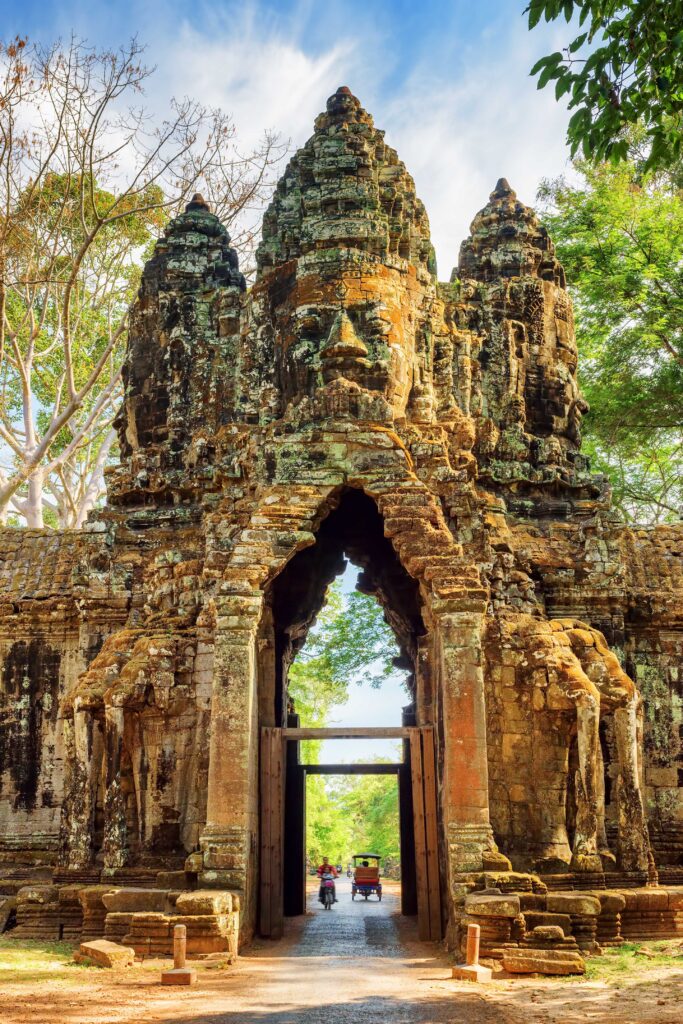
The Largest Religious Monument in the World, Cambodia’s Architectural Jewel Angkor Wat is a Temple to Spectacular Ancient Construction
Located in the lush forests of Cambodia’s sultry northern province Siem Reap, Angkor Wat has stood—and withstood—the tests of time. A long time, over 900 years, making this elaborate stone city part of an exclusive club of age-old architecture with instant name recognition: the Pyramids, the Parthenon, Machu Picchu.
Until a French explorer rediscovered the site in the 1840s, helping bring Angkor Wat to the attention of the West, the temple complex was not widely known on our side of the world. But today, a spike in tourism, the temple’s 1992 designation as a UNESCO World Heritage Site, and the digital platforming of its elegant spires, exaggerated galleries, and intricate bas-reliefs have all conspired to put this majestic Southeast Asian edifice on the must-see map of ancient architectural marvels.
Originally built as a Hindu temple by the Khmer king Suryavarman II over a 30-year period at the beginning of the 12th century, Angkor Wat is in some ways a temple of two religions. Hinduism was the religion of its founding ruler, but by the century’s end, the temple was Buddhist, thanks to a succession of kings who were tolerant of Buddhist influence and allowed for its peaceful co-existence.
The site is Buddhist to this day, as evidenced by the procession of religious art and motifs throughout the site, and a legion of saffron-colored cloaked monks, with long-tailed macaques at their heels, wandering the grounds. Still, one sees the roots of Hinduism in the arrangement of Angkor Wat; the complex was built as a re-creation of the Hindu universe, with the temple’s soaring towers meant to represent the peaks of mystical Mount Meru—the center of the cosmos.
Angor Wat is certainly a world of its own. Massive, glorious, and particularly mind-blowing when one considers how this ingeniously engineered, sandstone-blocked spectacle was erected in the first place. With 300,000 laborers and 6,000 elephants, according to inscriptions, along with a steady drumbeat of quarried rock arriving by raft on the Siem Reap River.
Still, pretty primitive, and the possibility of the temple, let alone its existence, is breathtaking. It is not unlike grappling with the Great Pyramid of Giza or the Great Wall of China—Angkor Wat is stupendously out of grasp. Factually, it can be admired, but never fully believed. Not even in the face of it.
To actually be in the face of it takes a while. One doesn’t just pull up to the front of Angkor Wat. There are gallant gates, sculpturally decorated outer walls and an actual moat to bypass. From there, it’s all astonishment. Pools, libraries, and a three-story central temple complex with statues in various states and a maze of long interlinked galleries with unknown ends that serve as an ongoing storytelling apparatus.
The buildings go on and on, all with precipitously steep vertical ascensions. Reaching the top of any one of these stairways feels a little like bouldering. Simple stepping at first, then a gradual use of hands and knees. When scaling these stairs, taking in the degree of decorative detail, the construction of the whole staggering ensemble is almost too terrifying to consider. This is a work rendered by nerves of steel.
The erosion of the temples, from runaway roots cascading down walls to cracks in the stone, to limbless artifacts, only adds to their beauty. Perfection is all the little imperfections, the shows of time, of trial, and of unambiguous triumph. The environment is so immersive that when re-entering modern life, the newness is shocking. The place is a lost world.
It is also a place of discovery. Angkor Wat is the largest and best-known of the temples of Angkor, but it is one among hundreds of stone ruins. Among them is Bayon Temple: its root-infested edifice, which was featured alongside Angelina Jolie in Tomb Raider, is an Instagram sensation and a consistently popular draw in the 400-acre Angkor Archaeological Park. Angkor Thom, a fortified city-state from the 13th century and the last capital of the Khmer Empire, is another.
Any experience in Cambodia and Southeast Asia is enriched with some understanding of its history. It is often devastatingly sad, but also one of resiliency and endurance, embodied in the warmth, spirit and openness of its people.
Angkor Wat is the heart and soul of Cambodia, monumental in both scale and significance, and emblazoned on its national flag. Cambodians are fiercely proud of their architectural inheritance and keen to share it with the world.
Currently challenged by the extreme economic hardship wrought by the pandemic, Angkor Wat is, as ever, vital to the future of Cambodia—a temple to the beauty of a country determined to build.
Angkor Wat | tourismcambodia.com
Photography by iStock/BTWImages, iStock/Afonso Farias, iStock/Andrew Coleman